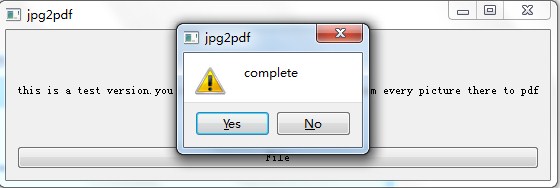用python 制作图片转pdf工具
最近因为想要看漫画,无奈下载的漫画是jpg的格式,网上的转换器还没一个好用的,于是乎就打算用python自己DIY一下:
这里主要用了reportlab。开始打算随便写几行,结果为若干坑纠结了挺久,于是乎就想想干脆把代码写好点吧。
实现了以下的几项功能:
将当前文件夹下的图片保存到一个pdf中,支持选择pdf大小等
如果有需要可以遍历它下面的所有文件夹
简单的来说完全满足我将漫画转成pdf格式的需求了。
碰到了一些问题,这里记录下:
一、中文路径:
这个实在是略蛋疼,总之就是尽量都decode一遍。然后注意win下的路径是\,要将其转化成/。然后路径遍历的时候也要注意路径怎么写的。
二、reportlab使用
这个说实话很简单,因为没考虑加点文字什么的其实就一句代码了
c.drawImage(filelist[i] , 0,0,maxw,maxh)
注意文件名也要各种decode啊。
总之借助强大的python有效代码就30行左右吧,代码地址
三、pyInstall的打包问题
开始是打算用py2exe结果打算接个简单的gui(真的是很简单)就开始跟我各种错,改的差不多想整成一个exe的时候有给我来个64bit not support。然后就转投pyInstall了,不过事情远不是那么顺利,如果用的是2.1版的话你会发现又有个巨大的bug--打包出来的exe居然不能放在中文路径下,于是乎各种找解决方案,然后发现了两种解决途径,一种是有个修改的版本(https://github.com/dkw72n/pyinstaller.git),另一种是选择2.0版。这个解决之后感觉这个比py2exe好多了,强烈推荐!
简单说下使用过程:
首先是安装:
1、下载安装pywin32;
2、下载pyInstall2.0版本(我觉得这样最好)
3、下载upx然后将文件夹中的upx.exe移动到pyInstall文件夹中
这样就完成了,连安装都不用(当然你安装也行。。。)
使用的话就是
python pyinstaller.py -F c:\scripts\main.py
如果不想要黑框的话再加个-w的参数就好。其他参数:
-F, --onefile Py代码只有一个文件
-D, --onedir Py代码放在一个目录中(默认是这个)
-K, --tk 包含TCL/TK
-d, --debug 生成debug模式的exe文件
-w, --windowed, --noconsole 窗体exe文件(Windows Only)
-c, --nowindowed, --console 控制台exe文件(Windows Only)
-X, --upx 使用upx压缩exe文件
-o DIR, --out=DIR 设置spec文件输出的目录,默认在PyInstaller同目录
--icon= 加入图标(Windows Only)
-v FILE, --version=FILE 加入版本信息文件
最后pyqt了个丑陋的缩水的界面(好吧。。我承认我真不太会写)


打包大小9M,算是可以接受了
运行效果(还不错啦):

以上就是本文的全部内容了,希望小伙伴们喜欢。

Hot AI Tools

Undresser.AI Undress
AI-powered app for creating realistic nude photos

AI Clothes Remover
Online AI tool for removing clothes from photos.

Undress AI Tool
Undress images for free

Clothoff.io
AI clothes remover

AI Hentai Generator
Generate AI Hentai for free.

Hot Article

Hot Tools

Notepad++7.3.1
Easy-to-use and free code editor

SublimeText3 Chinese version
Chinese version, very easy to use

Zend Studio 13.0.1
Powerful PHP integrated development environment

Dreamweaver CS6
Visual web development tools

SublimeText3 Mac version
God-level code editing software (SublimeText3)

Hot Topics
 Is the conversion speed fast when converting XML to PDF on mobile phone?
Apr 02, 2025 pm 10:09 PM
Is the conversion speed fast when converting XML to PDF on mobile phone?
Apr 02, 2025 pm 10:09 PM
The speed of mobile XML to PDF depends on the following factors: the complexity of XML structure. Mobile hardware configuration conversion method (library, algorithm) code quality optimization methods (select efficient libraries, optimize algorithms, cache data, and utilize multi-threading). Overall, there is no absolute answer and it needs to be optimized according to the specific situation.
 Is there any mobile app that can convert XML into PDF?
Apr 02, 2025 pm 08:54 PM
Is there any mobile app that can convert XML into PDF?
Apr 02, 2025 pm 08:54 PM
An application that converts XML directly to PDF cannot be found because they are two fundamentally different formats. XML is used to store data, while PDF is used to display documents. To complete the transformation, you can use programming languages and libraries such as Python and ReportLab to parse XML data and generate PDF documents.
 How to control the size of XML converted to images?
Apr 02, 2025 pm 07:24 PM
How to control the size of XML converted to images?
Apr 02, 2025 pm 07:24 PM
To generate images through XML, you need to use graph libraries (such as Pillow and JFreeChart) as bridges to generate images based on metadata (size, color) in XML. The key to controlling the size of the image is to adjust the values of the <width> and <height> tags in XML. However, in practical applications, the complexity of XML structure, the fineness of graph drawing, the speed of image generation and memory consumption, and the selection of image formats all have an impact on the generated image size. Therefore, it is necessary to have a deep understanding of XML structure, proficient in the graphics library, and consider factors such as optimization algorithms and image format selection.
 How to convert XML files to PDF on your phone?
Apr 02, 2025 pm 10:12 PM
How to convert XML files to PDF on your phone?
Apr 02, 2025 pm 10:12 PM
It is impossible to complete XML to PDF conversion directly on your phone with a single application. It is necessary to use cloud services, which can be achieved through two steps: 1. Convert XML to PDF in the cloud, 2. Access or download the converted PDF file on the mobile phone.
 How to open xml format
Apr 02, 2025 pm 09:00 PM
How to open xml format
Apr 02, 2025 pm 09:00 PM
Use most text editors to open XML files; if you need a more intuitive tree display, you can use an XML editor, such as Oxygen XML Editor or XMLSpy; if you process XML data in a program, you need to use a programming language (such as Python) and XML libraries (such as xml.etree.ElementTree) to parse.
 Recommended XML formatting tool
Apr 02, 2025 pm 09:03 PM
Recommended XML formatting tool
Apr 02, 2025 pm 09:03 PM
XML formatting tools can type code according to rules to improve readability and understanding. When selecting a tool, pay attention to customization capabilities, handling of special circumstances, performance and ease of use. Commonly used tool types include online tools, IDE plug-ins, and command-line tools.
 What is the function of C language sum?
Apr 03, 2025 pm 02:21 PM
What is the function of C language sum?
Apr 03, 2025 pm 02:21 PM
There is no built-in sum function in C language, so it needs to be written by yourself. Sum can be achieved by traversing the array and accumulating elements: Loop version: Sum is calculated using for loop and array length. Pointer version: Use pointers to point to array elements, and efficient summing is achieved through self-increment pointers. Dynamically allocate array version: Dynamically allocate arrays and manage memory yourself, ensuring that allocated memory is freed to prevent memory leaks.
 What is the process of converting XML into images?
Apr 02, 2025 pm 08:24 PM
What is the process of converting XML into images?
Apr 02, 2025 pm 08:24 PM
To convert XML images, you need to determine the XML data structure first, then select a suitable graphical library (such as Python's matplotlib) and method, select a visualization strategy based on the data structure, consider the data volume and image format, perform batch processing or use efficient libraries, and finally save it as PNG, JPEG, or SVG according to the needs.






